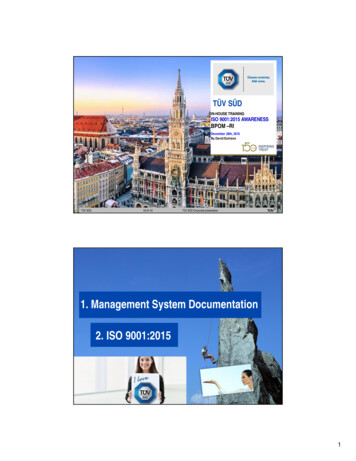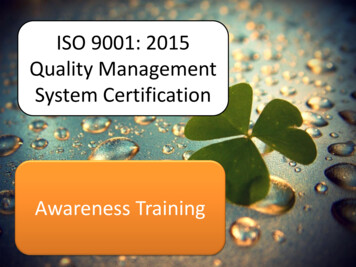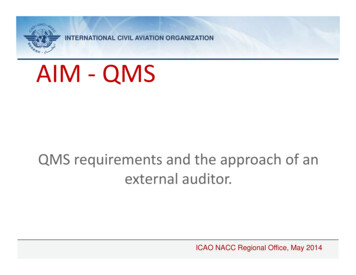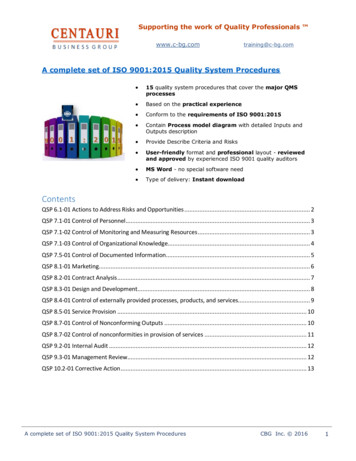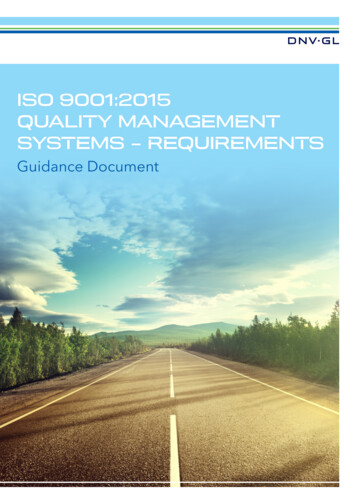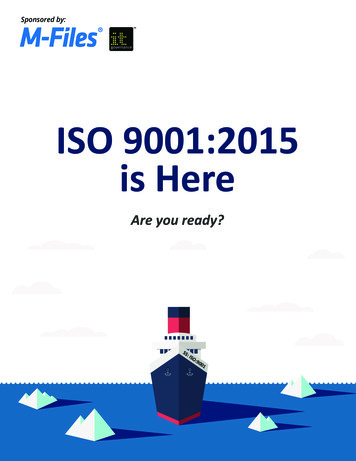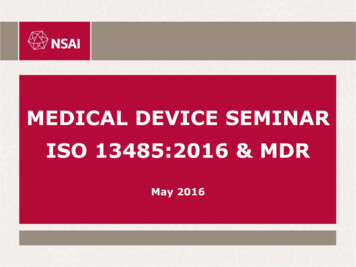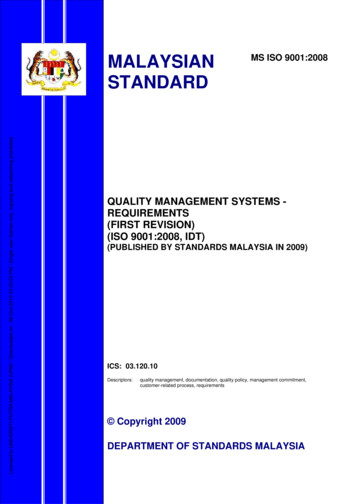
Transcription
Licensed to UNIVERSITI PUTRA MALAYSIA (UPM) / Downloaded on : 06-Oct-2015 03:20:02 PM / Single user license only, copying and networking prohibitedMALAYSIANSTANDARDMS ISO 9001:2008QUALITY MANAGEMENT SYSTEMS REQUIREMENTS(FIRST REVISION)(ISO 9001:2008, IDT)(PUBLISHED BY STANDARDS MALAYSIA IN 2009)ICS: 03.120.10Descriptors:quality management, documentation, quality policy, management commitment,customer-related process, requirements Copyright 2009DEPARTMENT OF STANDARDS MALAYSIA
DEVELOPMENT OF MALAYSIAN STANDARDSThe Department of Standards Malaysia (STANDARDS MALAYSIA) is the nationalstandardisation and accreditation body.The main function of the Department is to foster and promote standards,Licensed to UNIVERSITI PUTRA MALAYSIA (UPM) / Downloaded on : 06-Oct-2015 03:20:02 PM / Single user license only, copying and networking prohibitedstandardisation and accreditation as a means of advancing the national economy,promoting industrial efficiency and development, benefiting the health and safety ofthe public, protecting the consumers, facilitating domestic and international trade andfurthering international cooperation in relation to standards and standardisation.Malaysian Standards are developed through consensus by committees whichcomprise of balanced representation of producers, users, consumers and others withrelevant interests, as may be appropriate to the subject in hand. To the greatestextent possible, Malaysian Standards are aligned to or are adoption of internationalstandards. Approval of a standard as a Malaysian Standard is governed by theStandards of Malaysia Act 1996 (Act 549). Malaysian Standards are reviewedperiodically. The use of Malaysian Standards is voluntary except in so far as they aremade mandatory by regulatory authorities by means of regulations, local by-laws orany other similar ways.The Department of Standards appoints SIRIM Berhad as the agent to developMalaysian Standards. The Department also appoints SIRIM Berhad as the agent fordistribution and sale of Malaysian Standards.For further information on Malaysian Standards, please contact:Department of Standards MalaysiaCentury Square, Level 1 & 2Block 2300, Jalan Usahawan63000 CyberjayaSelangor D.E.MALAYSIAORSIRIM Berhad(Company No. 367474 - V)1, Persiaran Dato’ MenteriP.O. Box 7035, Section 240911 Shah AlamSelangor D.E.Tel: 60 3 83180002Fax: 60 3 83181455Tel: 60 3 5544 6000Fax: 60 3 5510 sirim.myE-mail: central@standardsmalaysia.gov.my STANDARDS MALAYSIA 2009 - All rights reserved
MS ISO 9001:2008CONTENTSLicensed to UNIVERSITI PUTRA MALAYSIA (UPM) / Downloaded on : 06-Oct-2015 03:20:02 PM / Single user license only, copying and networking prohibitedPageCommittee representation .iiiNational foreword.iv1Scope.11.1General .11.2Application .12Normative references .13Terms and definitions .14Quality management system .24.1General requirements.24.2Documentation requirements .25Management responsibility.35.1Management commitment .35.2Customer focus .45.3Quality policy .45.4Planning.45.5Responsibility, authority and communication .45.6Management review .56Resource management .66.1Provision of resources .66.2Human resources .66.3Infrastructure.66.4Work environment .67Product realization.7 STANDARDS MALAYSIA 2009 - All rights reservedi
MS ISO 9001:2008CONTENTS (continued)Licensed to UNIVERSITI PUTRA MALAYSIA (UPM) / Downloaded on : 06-Oct-2015 03:20:02 PM / Single user license only, copying and networking prohibitedPage7.1Planning of product realization .77.2Customer-related processes .77.3Design and development.87.4Purchasing.97.5Production and service provision . 107.6Control of monitoring and measuring equipment . 118Measurement, analysis and improvement. 128.1General . 128.2Monitoring and measurement. 128.3Control of nonconforming product . 138.4Analysis of data . 138.5Improvement. 14Annex A (informative) Correspondence between ISO 9001:2008 and ISO 14001:2004. 15Annex B (informative) Changes between ISO 9001:2000 and ISO 9001:2008 . 20Bibliography . 26ii STANDARDS MALAYSIA 2009 - All rights reserved
MS ISO 9001:2008Committee representationLicensed to UNIVERSITI PUTRA MALAYSIA (UPM) / Downloaded on : 06-Oct-2015 03:20:02 PM / Single user license only, copying and networking prohibitedThe Industry Standards Committee on Quality Management and Quality Assurance (ISC Y) under whose authoritythis Malaysian Standard was adopted, comprises representatives from the following organisations:Department of Standards MalaysiaFederation of Malaysian ManufacturersInstitute of Quality MalaysiaLembaga Pembangunan Industri Pembinaan MalaysiaMalaysian Administrative, Modernisation and Management Planning UnitMalaysian Agricultural Research and Development InstituteMalaysian Automotive AssociationMalaysian Institute of ManagementMalaysian International Chamber of Commerce and IndustryMinistry of International Trade and Industry MalaysiaNational Pharmaceutical Control BureauPERODUA Manufacturing Sdn BhdPerusahaan Otomobil Nasional BerhadScience and Technology Research Institute for DefenceSIRIM BerhadSIRIM QAS International Sdn BhdThe Institution of Engineers, MalaysiaUniversiti MalayaUniversiti Utara MalaysiaThe Technical Committee on Quality Management and Quality Assurance - TC2 on Quality Systems whichrecommended the adoption of the ISO Standard consists of representatives from the following organisations:Department of Standards MalaysiaFederation of Malaysian ManufacturersInstitute of Quality MalaysiaLembaga Pembangunan Industri Pembinaan MalaysiaMalaysian Administrative, Modernisation and Management Planning UnitMalaysian International Chamber of Commerce and IndustryScience and Technology Research Institute for DefenceSIRIM QAS International Sdn BhdUniversiti Utara Malaysia STANDARDS MALAYSIA 2009 - All rights reservediii
MS ISO 9001:2008NATIONAL FOREWORDLicensed to UNIVERSITI PUTRA MALAYSIA (UPM) / Downloaded on : 06-Oct-2015 03:20:02 PM / Single user license only, copying and networking prohibitedThe adoption of the ISO Standard as a Malaysian Standard was recommended by theTechnical Committee on Quality Management and Quality Assurance - TC2 on QualitySystems under the authority of the Industry Standards Committee on Quality Managementand Quality Assurance.This Malaysian Standard is the first revision of MS ISO 9001, Quality management systems Requirements.This Malaysian Standard is identical with ISO 9001:2008, Quality management systems Requirements, published by the International Organization for Standardization (ISO).However, for the purposes of this Malaysian Standard, the following apply:a)in the source text, "this International Standard" should read "this Malaysian Standard";b)the comma which is used as a decimal sign (if any), to read as a point; andc)reference to International Standards should be replaced by equivalent MalaysianStandards as follows:Referenced International StandardsCorresponding Malaysian StandardsISO 9000:2005, Quality managementsystems - Fundamentals and vocabularyMS ISO 9000:2005, Quality managementsystems - Fundamentals and vocabularyThis Malaysian Standard cancels and replaces MS ISO 9001:2000.Compliance with a Malaysian Standard does not of itself confer immunity from legalobligations.NOTE. IDT on the front cover indicates an identical standard i.e. a standard where the technical content, structure,wording (or is an identical translation) of a Malaysian Standard is exactly the same as in an International Standard oris identical in technical content and structure although it may contain the minimal editorial changes specified in clause4.2 of ISO/IEC Guide 21-1.iv STANDARDS MALAYSIA 2009 - All rights reserved
MS ISO 9001:2008Licensed to UNIVERSITI PUTRA MALAYSIA (UPM) / Downloaded on : 06-Oct-2015 03:20:02 PM / Single user license only, copying and networking prohibitedForewordISO (the International Organization for Standardization) is a worldwide federation of national standards bodies(ISO member bodies). The work of preparing International Standards is normally carried out through ISOtechnical committees. Each member body interested in a subject for which a technical committee has beenestablished has the right to be represented on that committee. International organizations, governmental andnon-governmental, in liaison with ISO, also take part in the work. ISO collaborates closely with the InternationalElectrotechnical Commission (IEC) on all matters of electrotechnical standardization.International Standards are drafted in accordance with the rules given in the ISO/IEC Directives, Part 2.The main task of technical committees is to prepare International Standards. Draft International Standardsadopted by the technical committees are circulated to the member bodies for voting. Publication as anInternational Standard requires approval by at least 75 % of the member bodies casting a vote.Attention is drawn to the possibility that some of the elements of this document may be the subject of patentrights. ISO shall not be held responsible for identifying any or all such patent rights.ISO 9001 was prepared by Technical Committee ISO/TC 176, Quality management and quality assurance,Subcommittee SC 2, Quality systems.This fourth edition cancels and replaces the third edition (ISO 9001:2000), which has been amended to clarifypoints in the text and to enhance compatibility with ISO 14001:2004.Details of the changes between the third edition and this fourth edition are given in Annex B.2009 – All2009rights- reservedSTRALAYSIAMALAYSIA STANDARDSAll rights reservedV
MS ISO 9001:2008Introduction0.1 GeneralLicensed to UNIVERSITI PUTRA MALAYSIA (UPM) / Downloaded on : 06-Oct-2015 03:20:02 PM / Single user license only, copying and networking prohibitedThe adoption of a quality management system should be a strategic decision of an organization. The designand implementation of an organization's quality management system is influenced bya) its organizational environment, changes in that environment, and the risks associated with thatenvironment,b) its varying needs,c) its particular objectives,d) the products it provides,e) the processes it employs,f)its size and organizational structure.It is not the intent of this International Standard to imply uniformity in the structure of quality managementsystems or uniformity of documentation.The quality management system requirements specified in this International Standard are complementary torequirements for products. Information marked “NOTE” is for guidance in understanding or clarifying theassociated requirement.This International Standard can be used by internal and external parties, including certification bodies, toassess the organization's ability to meet customer, statutory and regulatory requirements applicable to theproduct, and the organization's own requirements.The quality management principles stated in ISO 9000 and ISO 9004 have been taken into consideration duringthe development of this International Standard.0.2 Process approachThis International Standard promotes the adoption of a process approach when developing, implementing andimproving the effectiveness of a quality management system, to enhance customer satisfaction by meetingcustomer requirements.For an organization to function effectively, it has to determine and manage numerous linked activities. Anactivity or set of activities using resources, and managed in order to enable the transformation of inputs intooutputs, can be considered as a process. Often the output from one process directly forms the input to the next.The application of a system of processes within an organization, together with the identification and interactionsof these processes, and their management to produce the desired outcome, can be referred to as the “processapproach”.An advantage of the process approach is the ongoing control that it provides over the linkage between theindividual processes within the system of processes, as well as over their combination and interaction.When used within a quality management system, such an approach emphasizes the importance ofa) understanding and meeting requirements,b) the need to consider processes in terms of added value,vi STANDARDSMALAYSIA2008- All-rightsreserved STANDARDSMALAYSIA2009All rightsreserved
MSMSISOISO 9001:20089001:2008c) obtaining results of process performance and effectiveness, andd) continual improvement of processes based on objective measurement.The model of a process-based quality management system shown in Figure 1 illustrates the process linkagespresented in Clauses 4 to 8. This illustration shows that customers play a significant role in definingrequirements as inputs. Monitoring of customer satisfaction requires the evaluation of information relating tocustomer perception as to whether the organization has met the customer requirements. The model shown inFigure 1 covers all the requirements of this International Standard, but does not show processes at a detailedlevel.Licensed to UNIVERSITI PUTRA MALAYSIA (UPM) / Downloaded on : 06-Oct-2015 03:20:02 PM / Single user license only, copying and networking prohibitedNOTE In addition, the methodology known as “Plan-Do-Check-Act” (PDCA) can be applied to all processes. PDCA can bebriefly described as follows.Plan: establish the objectives and processes necessary to deliver results in accordance with customer requirements and theorganization's policies.Do: implement the processes.Check: monitor and measure processes and product against policies, objectives and requirements for the product andreport the results.Act: take actions to continually improve process performance.Figure 1 — Model of a process-based quality management system STANDARDS MALAYSIA 2009 - All rights reservedviiivii
MS ISO 9001:20080.3 Relationship with ISO 9004ISO 9001 and ISO 9004 are quality management system standards which have been designed to complementeach other, but can also be used independently.Licensed to UNIVERSITI PUTRA MALAYSIA (UPM) / Downloaded on : 06-Oct-2015 03:20:02 PM / Single user license only, copying and networking prohibitedISO 9001 specifies requirements for a quality management system that can be used for internal application byorganizations, or for certification, or for contractual purposes. It focuses on the effectiveness of the qualitymanagement system in meeting customer requirements.At the time of publication of this International Standard, ISO 9004 is under revision. The revised edition ofISO 9004 will provide guidance to management for achieving sustained success for any organization in acomplex, demanding, and ever changing, environment. ISO 9004 provides a wider focus on qualitymanagement than ISO 9001; it addresses the needs and expectations of all interested parties and theirsatisfaction, by the systematic and continual improvement of the organization’s performance. However, it is notintended for certification, regulatory or contractual use.0.4 Compatibility with other management systemsDuring the development of this International Standard, due consideration was given to the provisions ofISO 14001:2004 to enhance the compatibility of the two standards for the benefit of the user community.Annex A shows the correspondence between ISO 9001:2008 and ISO 14001:2004.This International Standard does not include requirements specific to other management systems, such asthose particular to environmental management, occupational health and safety management, financialmanagement or risk management. However, this International Standard enables an organization to align orintegrate its own quality management system with related management system requirements. It is possible foran organization to adapt its existing management system(s) in order to establish a quality management systemthat complies with the requirements of this International Standard.viii STANDARDS MALAYSIA 2009 - All rights reserved
MS ISO 9001:2008Quality management systems — RequirementsLicensed to UNIVERSITI PUTRA MALAYSIA (UPM) / Downloaded on : 06-Oct-2015 03:20:02 PM / Single user license only, copying and networking prohibited1 Scope1.1 GeneralThis International Standard specifies requirements for a quality management system where an organizationa) needs to demonstrate its ability to consistently provide product that meets customer and applicablestatutory and regulatory requirements, andb) aims to enhance customer satisfaction through the effective application of the system, including processesfor continual improvement of the system and the assurance of conformity to customer and applicablestatutory and regulatory requirements.NOTE 1 In this International Standard, the term “product” only applies toa)product intended for, or required by, a customer,b)any intended output resulting from the product realization processes.NOTE 2 Statutory and regulatory requirements can be expressed as legal requirements.1.2 ApplicationAll requirements of this International Standard are generic and are intended to be applicable to allorganizations, regardless of type, size and product provided.Where any requirement(s) of this International Standard cannot be applied due to the nature of an organizationand its product, this can be considered for exclusion.Where exclusions are made, claims of conformity to this International Standard are not acceptable unless theseexclusions are limited to requirements within Clause 7, and such exclusions do not affect the organization'sability, or responsibility, to provide product that meets customer and applicable statutory and regulatoryrequirements.2 Normative referencesThe following referenced documents are indispensable for the application of this document. For datedreferences, only the edition cited applies. For undated references, the latest edition of the referenced document(including any amendments) applies.ISO 9000:2005, Quality management systems — Fundamentals and vocabulary3 Terms and definitionsFor the purposes of this document, the terms and definitions given in ISO 9000 apply.Throughout the text of this International Standard, wherever the term “product” occurs, it can also mean“service”. STANDARDS MALAYSIA 20092009- –AllAllrightsrightsreservedreserved 1
MS ISOISO9001:20089001:2008MS4 Quality management system4.1 General requirementsThe organization shall establish, document, implement and maintain a quality management system andcontinually improve its effectiveness in accordance with the requirements of this International Standard.The organization shallLicensed to UNIVERSITI PUTRA MALAYSIA (UPM) / Downloaded on : 06-Oct-2015 03:20:02 PM / Single user license only, copying and networking prohibiteda) determine the processes needed for the quality management system and their application throughout theorganization (see 1.2),b) determine the sequence and interaction of these processes,c) determine criteria and methods needed to ensure that both the operation and control of these processesare effective,d) ensure the availability of resources and information necessary to support the operation and monitoring ofthese processes,e) monitor, measure where applicable, and analyse these processes, andf)implement actions necessary to achieve planned results and continual improvement of these processes.These processes shall be managed by the organization in accordance with the requirements of thisInternational Standard.Where an organization chooses to outsource any process that affects product conformity to requirements, theorganization shall ensure control over such processes. The type and extent of control to be applied to theseoutsourced processes shall be defined within the quality management system.NOTE 1 Processes needed for the quality management system referred to above include processes for managementactivities, provision of resources, product realization, measurement, analysis and improvement.NOTE 2 An “outsourced process” is a process that the organization needs for its quality management system and whichthe organization chooses to have performed by an external party.NOTE 3 Ensuring control over outsourced processes does not absolve the organization of the responsibility of conformityto all customer, statutory and regulatory requirements. The type and extent of control to be applied to the outsourcedprocess can be influenced by factors such asa)the potential impact of the outsourced process on the organization's capability to provide product that conforms torequirements,b) the degree to which the control for the process is shared,c)the capability of achieving the necessary control through the application of 7.4.4.2 Documentation requirements4.2.1 GeneralThe quality management system documentation shall includea) documented statements of a quality policy and quality objectives,b) a quality manual,c) documented procedures and records required by this International Standard, andd) documents, including records, determined by the organization to be necessary to ensure the effectiveplanning, operation and control of its processes.2 STANDARDSSTANDARDSMALAYSIAMALAYSIA20082009- -AllAllrightsrightsreservedreserved
MS ISOI 9001:2008NOTE 1 Where the term “documented procedure” appears within this International Standard, this means that theprocedure is established, documented, implemented and maintained. A single document may address the requirements forone or more procedures. A requirement for a documented procedure may be covered by more than one document.NOTE 2 The extent of the quality management system documentation can differ from one organization to another due toa)the size of organization and type of activities,b) the complexity of processes and their interactions, andc)the competence of personnel.Licensed to UNIVERSITI PUTRA MALAYSIA (UPM) / Downloaded on : 06-Oct-2015 03:20:02 PM / Single user license only, copying and networking prohibitedNOTE 3 The documentation can be in any form or type of medium.4.2.2 Quality manualThe organization shall establish and maintain a quality manual that includesa) the scope of the quality management system, including details of and justification for any exclusions(see 1.2),b) the documented procedures established for the quality management system, or reference to them, andc) a description of the interaction between the processes of the quality management system.4.2.3 Control of documentsDocuments required by the quality management system shall be controlled. Records are a special type ofdocument and shall be controlled according to the requirements given in 4.2.4.A documented procedure shall be established to define the controls neededa) to approve documents for adequacy prior to issue,b) to review and update as necessary and re-approve documents,c) to ensure that changes and the current revision status of documents are identified,d) to ensure that relevant versions of applicable documents are available at points of use,e) to ensure that documents remain legible and readily identifiable,f)to ensure that documents of external origin determined by the organization to be necessary for the planningand operation of the quality management system are identified and their distribution controlled, andg) to prevent the unintended use of obsolete documents, and to apply suitable identification to them if they areretained for any purpose.4.2.4 Control of recordsRecords established to provide evidence of conformity to requirements and of the effective operation of thequality management system shall be controlled.The organization shall establish a documented procedure to define the controls needed for the identification,storage, protection, retrieval, retention and disposition of records.Records shall remain legible, readily identifiable and retrievable.5 Management responsibility5.1 Management commitmentTop management shall provide evidence of its commitment to the development and implementation of thequality management system and continually improving its effectiveness by ISOSTANDARDSMALAYSIA2008- -AllAllrightsrightsreservedreserved STANDARDS20092008 – AllMALAYSIArightsreserved3
MS ISOISO9001:20089001:2008a) communicating to the organization the importance of meeting customer as well as statutory and regulatoryrequirements,b) establishing the quality policy,c) ensuring that quality objectives are established,d) conducting management reviews, ande) ensuring the availability of resources.Licensed to UNIVERSITI PUTRA MALAYSIA (UPM) / Downloaded on : 06-Oct-2015 03:20:02 PM / Single user license only, copying and networking prohibited5.2 Customer focusTop management shall ensure that customer requirements are determined and are met with the aim ofenhancing customer satisfaction (see 7.2.1 and 8.2.1).5.3 Quality policyTop management shall ensure that the quality policya) is appropriate to the purpose of the organization,b) includes a commitment to comply with requirements and continually improve the effectiveness of the qualitymanagement system,c) provides a framework for establishing and reviewing quality objectives,d) is communicated and understood within the organization, ande) is reviewed for continuing suitability.5.4 Planning5.4.1 Quality objectivesTop management shall ensure that quality objectives, including those needed to meet requirements for product[see 7.1 a)], are established at relevant functions and levels within the organization. The quality objectives shallbe measurable and consistent with the quality policy.5.4.2 Quality management system planningTop management shall ensure thata) the planning of the quality management system is carried out in order to meet the requirements given in 4.1,as well as the quality objectives, andb) the integrity of the quality management system is maintained when changes to the quality managementsystem are planned and implemented.5.5 Responsibility, authority and communication5.5.1 Responsibility and authorityTop management shall ensure that responsibilities and authorities are defined and communicated within theorganization.4 STANDARDS MALAYSIAMALAYSIA2008 –-- AllAllrightsreserved ISO 2009All rightsrights reservedreserved STANDARDS2009
ISO9001:20089001:2008MSMSISO5.5.2 Management representativeTop management shall appoint a member of the organization's management who, irrespective of otherresponsibilities, shall have responsibility and authority that includesa) ensuring that processes needed for the quality management system are established, implemented andmaintained,b) reporting to top management
This Malaysian Standard is the first revision of MS ISO 9001, Quality management systems - Requirements. This Malaysian Standard is identical with ISO 9001:2008, Quality management systems - Requirements, published by the International Organization for Standardization (ISO). However, for the


